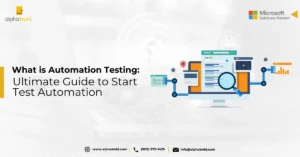Introduction
Test automation is crucial to software development and quality assurance in today’s fast-paced digital landscape. Businesses may speed up their testing procedures, increase productivity, and bring high-quality software solutions to market more quickly by utilizing the potential of automation. This comprehensive guide will explore the best practices for test automation in 2024, providing you with a detailed checklist to help you optimize your automation efforts and stay ahead of the competition.
Manual testing includes repetitive tasks which can become monotonous and lead to mistakes. Repeating the same tests multiple times can also reduce the tester’s accuracy. In contrast, test automation offers consistent and reliable accuracy. Test suites can be reused, speeding up the testing process, while testers can focus on creating new scenarios and test cases to improve test coverage. Test automation can also help businesses save money. Additionally, frequent and early testing can save time and help identify issues quickly.
Read more: Role of Artificial Intelligence (AI) in Automation Testing

Elevate your QA Testing with Automation!
Embark on a journey to superior testing methodologies with AlphaBOLD. Discover how our expertise in automated testing can elevate the quality and efficiency of your software development lifecycle.
Request a ConsultationIn this article, we’ll walk you through some best practices for test automation:
1. Define Clear Objectives
Before embarking on your test automation journey, it’s essential to establish clear objectives. Identify the goals you want to achieve through automation, such as reducing testing time, increasing test coverage, or improving overall software quality. By defining these objectives upfront, you can align your automation strategy with your business goals and ensure your efforts are focused and effective.
2. Select the Right Test Automation Framework
Choosing the right test automation framework is critical for the success of your automation initiatives. Evaluate different frameworks based on scalability, flexibility, ease of use, and community support. Popular frameworks like Selenium, Appium, and TestComplete offer robust features and extensive community support, making them excellent choices for different types of applications.
3. Conduct Comprehensive Test Planning
Test planning is a crucial step in the test automation process. Create a detailed test plan that outlines the scope of your automation efforts, identifies the test scenarios to be automated, and establishes the expected outcomes. Consider test data, environment setup, and test execution schedules to ensure a smooth and efficient automation process.
4. Prioritize Test Cases for Automation
Not all test cases are suitable for automation. Prioritize your test cases based on their complexity, execution frequency, and business impact. Start by automating the critical and repetitive test cases that yield the most significant value. This approach allows you to maximize your resources and focus on areas where automation can deliver the most significant return on investment.
5. Design Robust and Maintainable Test Scripts
When designing your test scripts, it’s crucial to prioritize robustness and maintainability. Follow best practices such as using a modular and data-driven approach, implementing effective error-handling mechanisms, and leveraging page object models for better code organization. Well-designed test scripts are easier to maintain, enhance, and troubleshoot, ensuring the long-term success of your automation efforts.
6. Implement Continuous Integration and Delivery
Integrating test automation into your CI/CD (Continuous Integration/Continuous Delivery) pipeline is essential for achieving faster feedback loops and accelerating the software delivery process. By automating your tests and seamlessly integrating them into your development workflows, you can detect issues early, facilitate quick bug fixes, and ensure a smooth release cycle.
7. Regularly Maintain and Update Test Scripts
Test automation is an ongoing process that requires regular maintenance and updates. As your application evolves, so should your test scripts. Regularly review and update your test scripts to align with changes in the application’s functionality, user interface, or underlying technology stack. This practice guarantees that your automation suite remains relevant and effective in catching potential regressions.
8. Monitor and Analyze Test Results
Effective test automation goes beyond running test scripts. Implement a robust monitoring and analysis system to track test results, identify patterns, and gain insights into the overall quality of your software. Leverage tools and techniques for visual test reporting, performance analysis, and error tracking to facilitate data-driven decision-making and continuous improvement.
Explore Our Automation testing services
Use case: Company XYZ’s Success with Test Automation
Consider a use case where Company XYZ implemented test automation and achieved significant success. Company XYZ is a leading e-commerce platform that experiences high website traffic and frequent software updates. They faced challenges with manual testing, including the time-consuming nature of regression testing and the inability to cover a wide range of test scenarios.
Company XYZ transformed its testing process by adopting test automation and improving its software quality. They implemented Selenium, a popular test automation framework, and developed a comprehensive suite of automated tests. Here’s how test automation helped Company XYZ:
- Faster Regression Testing: Company XYZ reduced regression testing time significantly with automated tests in place. They were able to run their test suite on different browsers and devices simultaneously, ensuring consistent behavior across platforms.
- Increased Test Coverage: Test automation allowed Company XYZ to expand its test coverage. They automated various scenarios, including user registration, product search, checkout process, and payment gateway integration. They could now thoroughly test critical functionalities without compromising time or resources.
- Early Bug Detection: Automated tests detected issues early in the development cycle. Company XYZ could identify and fix bugs promptly, reducing the likelihood of bugs reaching production. This resulted in a more stable and reliable application for their users.
- Efficient Continuous Delivery: Company XYZ achieved faster and more efficient software releases by integrating test automation into their CI/CD pipeline. They could validate changes quickly, ensuring new features and bug fixes did not introduce regressions.
- Improved Customer Satisfaction: The enhanced software quality of test automation improved customer satisfaction. With fewer bugs and a smoother user experience, Company XYZ saw increased customer retention and positive reviews.
Read more: Codeless Automation Testing: The solution to all the testing challenges?
Step into the Future of Testing with Automation!
Take the first step towards a smarter, faster, and more reliable testing process with AlphaBOLD. Join us in embracing the best practices for test automation to ensure your software exceeds expectations.
Request a ConsultationConclusion
In conclusion, test automation played a pivotal role in Company XYZ’s success. It empowered them to streamline their testing processes, achieve faster feedback loops, increase test coverage, and ultimately deliver a high-quality e-commerce platform to their customers.
By adhering to these best practices for test automation in 2024, you can optimize your automation efforts and stay ahead of the competition. Define clear objectives, select the right framework, conduct comprehensive test planning, prioritize test cases, design robust scripts, implement CI/CD, maintain and update your scripts regularly, and monitor test results for continuous improvement. Embracing these practices will empower your organization to deliver high-quality software products efficiently and reliably.
Read more: Top 5 Programming Languages for Automation: A C-Level Guide
Explore Recent Blog Posts








